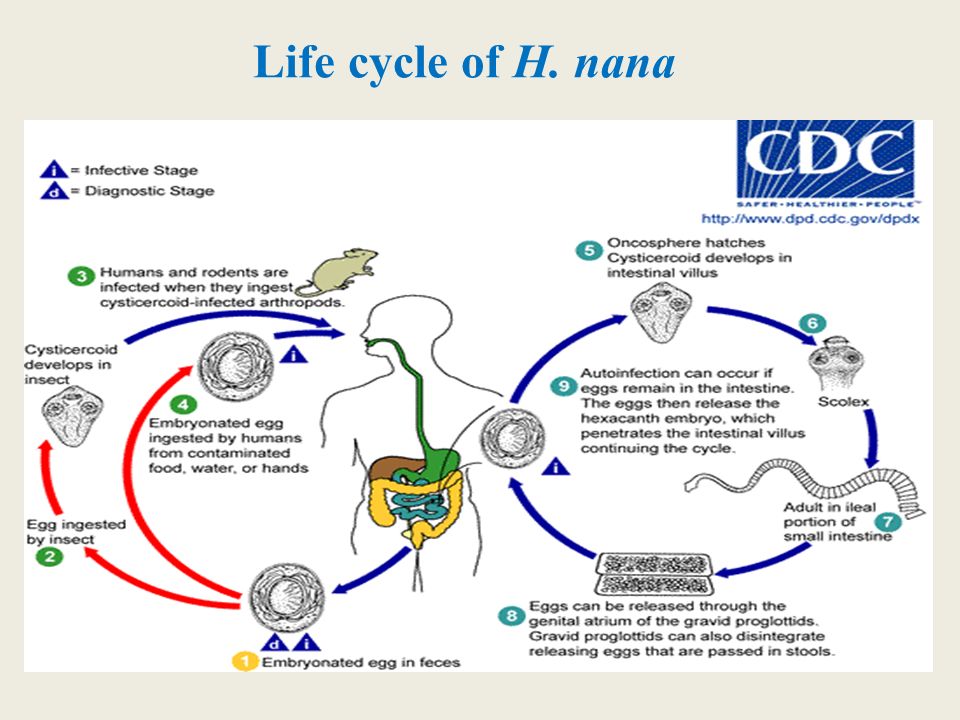
Hymenolepis nana
- Hymenolepis nana is also known as the dwarf tapeworm. The species name ‘nana’ is derived from its small size which means dwarf of the adult worm.
- It is the smallest and only cestode that parasites the Human without any intermediate host.
Habitat
- In Human: The adult worm resides in the ileal portion of the small intestine
- It is also present in other mammals like rats and mice
Morphology of Hymenolepis nana
- It is small and thread like worms measuring 1-4 cm in length with a diameter of 1mm.
- Body consists of a scolex, a long neck and strobili consists of nearly 200 proglolttids.
- The size of the storbila is usually inversely proportional to the number of worms present in the hosts.
Scolex:
- Scolex is globular, measuring 0.32 mm in diameter.
- It has four suckers and has a short rostellum armed with 20-30 spines in one ring.
- Rostellum is retractable and always remains invaginated at the apex of the organ.
Neck:
- It is relatively long and situated postenior to the head.
Strobila
- The strobila consists of nearly 200 segments or proglottids.
- Each mature segment measures 0.3 mm in length by 0.9 mm breadth.
- Proglottid contains both male and female reproductive organs. Genital pores are marginal and are situated on the same side. The uterus is a transverse sac with lobulated walls and there are three testes.
- Proglottids neat the neck regions are small, short, narrow and immature and those away from the scolex are mature and gravid.
- Segments at distal end are the gravid proglottids, which contain fertilized eggs.
Eggs of Hymenolepis nana:
- Eggs are the infective form of parasite to human.
- Eggs are liberated in the faeces by gradual disintegration of the terminal segments.
- Eggs are colorless, spherical or oval in shape, measuring 30-45mm in diameter. It has 2 distinct membranes. The outer membrane in thin and colorless. The inner membrane also known as embryophore encloses an oncosphere with 3 pairs of lancet shaped hooklets. The space between two membranes is filled with yolk granules and scolex filaments (4-8) flowing from the knobs at both end of embroyophore.
- Eggs float in saturated salt solution.
Life cycle of Hymenolepis nana:

- The life cycle is completed in a single host, man and does not require any intermediate host.
- Man and rat act as both definitive and intermediate hosts.
- H. nana are unique in that the helminthes do not multiply inside the body of the definitive host.
- Man acquires infections by injection of fully embroynated egg.
- In the small intestine a hexacanth embryo is liberated. It borrows into the villi of the anterior part of the small intestine and in about 4 days time develop into a typical larval stage called ‘cysticercoid’.
- After reaching maturity the ileum ruptures and the larva enters the lumen of the small intestine. Later, it attaches to another villus further down and in the course of fortnight develops into adult worms.
- The gravid proglolttids breaks off the adult worm and disintegrate to release embryonated eggs while it passes down the intestinal tract.
- The eggs passed in the faeces are the source of infection for new host and the cycle is continued.
- Sometimes, few eggs hatch out in the lumen of the small intestine and liberate embryos which directly invade the intestinal villi. This phase of infection is called internal autoinfection and is responsible for increased worms load in intestine.
- Some person infect own self by faeco-oral route due to bad personal hygiene. This is called external manifestation and is responsible for persistence of the infection in a host.
Pathogenesis and pathology of Hymenolepis nana infection:
Mode of transmission:
- Infected human faeces are the chief source of infection.
- Transmission of the man occurs-
- Through faecel-oral route by ingestion of eggs from contaminated hands.
- Frequently by contaminated food and water
- Rarely from ingestion of food contaminated fleas habouring the cysticercoid larva.
Pathogenesis
- Even large numbers of parasite is well tolerated.
- The mechanisms by which symptoms are usually produced is an allergic reaction.
- In heavy infections large number of worms may cause:
- Mechanical irritation of the intestine and produce various clinical manifestation and
- Various allergic manifestation such as anal and nasal pruritus by releasing toxic metabolites.
Clinical manifestation
- Hymenolepiasis occurs more commonly in children.
- The incubation period various from 15-39 days.
- Most infections are asymptomatic.
- In heavy infections, symptoms include irritability, diarrhea, abdominal pain, sleep disorder, anal pruritus and nasal pruritus.
- Rare symptoms anorexia, nausea and vomiting.
Complications
- These include bloody diarrhea and behavioural disturbances.
Epidemiology and Geographical Distribution of Hymenolepis nana:
- The parasite is cosmopolitan in distribution.
- It is the most common cestode causing infection in humans with more than 36 million infected worldwide.
- Most commonly children of 4-10 age are affected.
- The worm is found in temperate than tropical countries.
- It is highly prevalent in south Africa, South Europe , Latin America and middle-east Asia.
Laboratory diagnosis of Hymenolepis nana:
1.Specimen:
- Stool sample
- rectal swab
2. Microscopy:
- Diagnosis is based on the demonstration of characteristics eggs in the faeces by direct microscopy.
- The eggs can readily be concentrated by the salt flotation and formalin ether sedimentation technique.
3. Hematology:
- Eosiniphila of more than 5% is seen in 1/3rd of the infected children
4. Endoscopy:
- Adult worm can be identified during endoscopic examination
5. ELISA:
- It has 80% sensitivity
Treatment of Hymenolepis nana:
- Praziquantel: drug of choice
- Albendazole, Mebendazole
Prevention and control of parasitic infection:
- Sanitary improvements
- Uncontaminated food supplies
- Rodent control in house
- Personal hygiene
